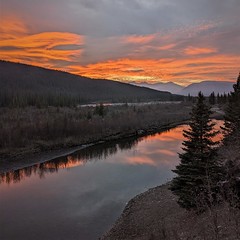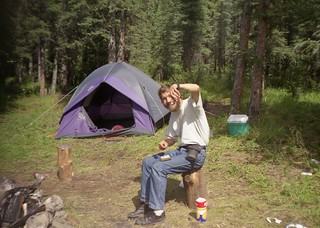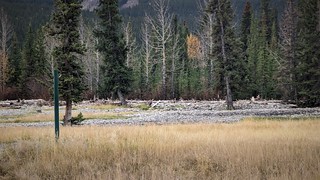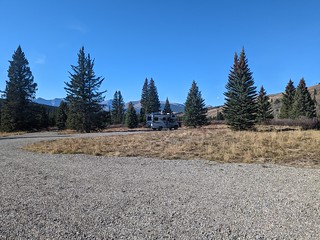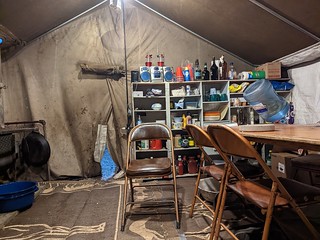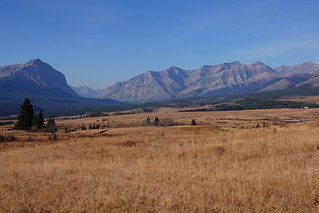Having hopefully fixed my furnace, I headed out into the Rocky Mountain Foothills again, this time to Ya Ha Tinda. I had been here many years ago camping, but had never really explored the area. Back then, camping was more drinking and way less exploring. This time I was on my own – I would explore as much as I could, on foot, and by motorcycle. I was curious to see what changes had happened – turns out a lot has changed in a quarter century.
It had been a long time since I had been out there, but between the googles and my memory, I found my way into the area again. The road is much improved from my last visit, but this was over twenty years ago – comparison is somewhat pointless over that much time. Thinking on it, it has been over twenty five years since I have been here. You’re getting old when you start counting in quarter centuries.
My first stop at Ya Ha Tinda’s Bighorn Campground was a bust. It seems the campground got washed out by some flooding early this year and was closed. Now what? I back track to Eagle Creek Campground, just outside of the Ya Ha Tinda ranch grounds, but close enough to hike back into everything. This campground was not there last time I was here, but the place we camped was just across from it – now unusable boondocking thanks to development right beside it in the form of YMCA Camp Gray Jay, and a Ranger cabin off to the other side of the camping spot, which was in between these two items.
I pick a spot out in the open for the solar power – it is not as nice as some of the sites in the trees, but the campground instructions say that non-horse people should try and take the sites without horse hitching facilities, which my sunny site did not have. Plus this campground was huge – if I really wanted to, I could move later if I so desired. The fact that everything was nicely graveled and level sealed it – this was my spot!
I can see another group not too far away just in the trees. It seems they are setup for a longer stay with canvas tents, and several horses. It turns out that the mix is about 70/30 horse/other camping people here at this time of year. With the place being mostly empty, it really didn’t matter if I took a “horse spot”. I had one additional bonus: I was near the trailhead to Eagle Lake, the one place in the area I had hiked to previously.
I was getting ready to visit the lake when I noticed something, or the lack of something. I had been going in and out of the RV and the door hinge was no longer squeaking! I had been dousing the offending hinge in lithium grease to no avail, and had just about given up on it. But it seemed that the last drive combined with all the lubrication finally freed up the thing. I don’t expect it to stay noise free, we will see!
Eagle Lake is mostly like I remembered it. They have some primitive camping close to the lake, but you can’t drive to it. You can take a quad – that trail is one of the few in the area where you could do that. But most people seem to walk – it is only about 30 minutes. There is even an outdoor toilet there now – not too bad a spot to come with a tent if you can’t walk too far. I gave it a couple of tries with the fishing rod. No bites, but I did see some tiny minnows in the water. Perhaps in a few years something bigger will be there for my lures.
Horse travel is the big thing out here, but just because they are ‘natural’ does not mean they are without environmental damage. The ‘road’ to Eagle Lake that was still there last time I was here is now a freeway of horse path lanes. I don’t know if the horses naturally do this on their own, or if it is the people guiding them, but man, it’s almost as bad as some of the quad damage in places. To be fair, quads can do a lot of damage quickly, but those horse hoofs can churn up a trail pretty good too.
Speaking of horses, the horse people closest to my camp invited me over for drinks one night. They were an interesting group of independent types. A couple at least have run several successful businesses. The tent they were staying in reminded me of an older style of camping you don’t see much outside of the hunting or horse group – big (plastic?) canvas tents with all the home fixings. No ‘camp size’ anything here. But when you need to bring horses, and their supplies, why bother with anything smaller or lighter for your personal needs? It is not something for short stay – these people were there for several weeks of trail riding and hunting. We were all of an age, I was the ‘young’ one there. We all could agree things had changed a lot out here, with a lot more people now. I found out that in the summer they even bring in tourist buses to have groups hike up to Eagle Lake. So much for any solitude then. We all agreed it might be better if the road were never paved going in – that gravel roads keeps out two thirds of the people right now.
The trail network is quite extensive around the area, thanks to all the horse people. While horse trails can be rougher for hiking, they are not all heavily used. That, and the lack of rain while I was their meant the trails were quite good by foot. You don’t want to be on a heavy use horse trail in the rain. You would be slogging through a mud trough the whole time. The scenery varies from fully treed to open prairie. In fact, the name “Ya Ha Tinda” is native for prairie near the mountains. Most areas this close to the mountains are all treed, the natives would have noted this patch of grassland up against the Rockies.
There were the Bighorn Falls to hike to, which I found to be more substantial than I expected, especially considering this was the low water fall season for the area. There are some other little falls and pools to hike to as well. Just don’t rely on the maps posted at the trail heads and at some markers – they are not good enough to navigate by. I used the googles and topo map apps. Even so, I never did find the upper Bighorn Falls.
I certainly was not going to be able to hike every trail in the area in the week I had – especially some of the more far flung ones. But having the motorcycle helped. I did a couple of days where I took the motorcycle to the Ya Ha Tinda trail head to Bighorn Falls, saving myself two hours of hiking added from my campground. I also scouted out some other camping spots that would be boondocking out there. One of my longest rides to date on gravel roads was to visit Panther River campground, another horse camp that looks like it would be good with the RV too. There is boondocking beyond that campground too.
 There are many horses in the area of the ranch, this being the wintering area for all the horses used by the Parks service for accessing the backcountry in the Rocky Mountain parks. I had these guys block my road, but they didn’t seem to care. Some seemed to be eying me as if I might have a treat for them when I stopped to take a picture. Nice tame horsey.
There are many horses in the area of the ranch, this being the wintering area for all the horses used by the Parks service for accessing the backcountry in the Rocky Mountain parks. I had these guys block my road, but they didn’t seem to care. Some seemed to be eying me as if I might have a treat for them when I stopped to take a picture. Nice tame horsey.
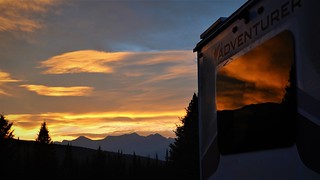 I left the area just as the weather was turning for the worse. The snow started falling just as I drove out in the morning. Only the previous day had been a mixed bag of rain and sun – the rest of the week had been a glorious late fall, with a wonderful sunset every night. The good weather was coming to an end – my plan was to wait out the snow a couple of days in Didsbury then start trekking south. I wanted to hold out in the warmest area I could find in SE British Columbia before heading into the USA. I only had five months remaining I could stay – didn’t want to be coming back in March 2023! Join me next time to see how those plans worked out!
I left the area just as the weather was turning for the worse. The snow started falling just as I drove out in the morning. Only the previous day had been a mixed bag of rain and sun – the rest of the week had been a glorious late fall, with a wonderful sunset every night. The good weather was coming to an end – my plan was to wait out the snow a couple of days in Didsbury then start trekking south. I wanted to hold out in the warmest area I could find in SE British Columbia before heading into the USA. I only had five months remaining I could stay – didn’t want to be coming back in March 2023! Join me next time to see how those plans worked out!

